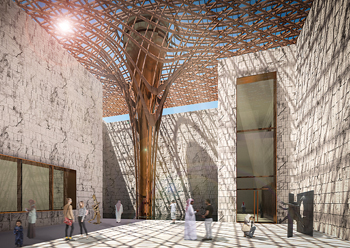Fortress for art
A unique art museum has been proposed for Sharjah, boasting wind towers, shaded courtyards and a roof canopy whose geometry is inspired by the complex motifs of Arabic architecture and by the ancient Emirati weaving traditions.
01 March 2020
The Sharjah-based Barjeel Art Foundation intends to build a unique art museum that resembles a fortress, which will be located in a semi-industrial area on the periphery of the UAE city.
The Barjeel Museum for Modern Arab Art has been designed by Aidia Studio of Mexico, which recently secured the first prize (Rifat Chadirji Prize 2019) in the Tamayouz Excellence Awards, one of the most recognised architecture awards in the Middle East, held last December in Amman, Jordan.
The project is in its concept stage, and the Barjeel Art Foundation is currently working on the funding for the museum, Natalia Wrzask, architect, co-founder and director of Aidia Studio, tells Gulf Construction.
The Barjeel Museum for Modern Arab Art will be housed in a 21,500-sq-m low-rise monolithic structure covering the entire footprint of the plot. The immediate context of the introverted complex of solid appearance is a gas station, a highway and a low-density residential district.
“The museum is not designed as an architectural object; the site and the surroundings would not justify such an approach,” says a spokeswoman for Aidia Studio. “We have, instead, proposed a porous mass which we have meticulously carved to create courtyards, alleys and passages, intertwined with the galleries and rest of the programme.”
It is an immersive experience for the visitor to subtract himself from reality, she adds.
The galleries are organised as a circuit which unfolds around the internal courtyards of the museum – it’s intended as a journey which is experienced gradually. The galleries are laid out below street level to shield the artwork from sun exposure and thermal gains and to control the amount of natural light coming in.
Filtered light is, however, introduced purposefully in the transition spaces between galleries letting the visitors catch a glimpse of the shaded exterior courtyards, water features and the base of the wind towers, she adds.
‘Barjeel’ is Arabic for wind tower and the architects have built this reference into the design of the complex. The spokeswoman explains: “In honour of the foundation’s name, we decided to reinterpret the traditional wind tower typology, reshaping it into a contemporary sculpture which not only serves as a cooling device but also adds value to the space.
“The wind towers work in tandem with the roof structure within the five courtyards of the museum; this way all outdoor spaces benefit from the effects of the wind, enhanced by the water evaporation from the pools.”
The complex geometry of the roof shading canopy contrasts with the simple forms of the museum. Glimpses of the wooden structure can be viewed from the exterior, but their full beauty can only be experienced from within the building, she says.
Its geometry is inspired by the complex motifs of Arabic architecture and by the ancient Emirati weaving traditions. The soft curvature of the funnels are made out of steam-bent wood – another Emirati tradition well known in the ship building industry.
“Its purpose, apart from creating a striking gesture, is to shade the courtyards, cool down the atmosphere and refract the sunlight. We have chosen wood as the material due to its low emissivity; its interweaving layers can be fully experienced from the rooftop promenade,” she remarks.
- Fortress for art
- GHD plays vital role in mangrove park project
- Sharjah geology park design cued by fossils



